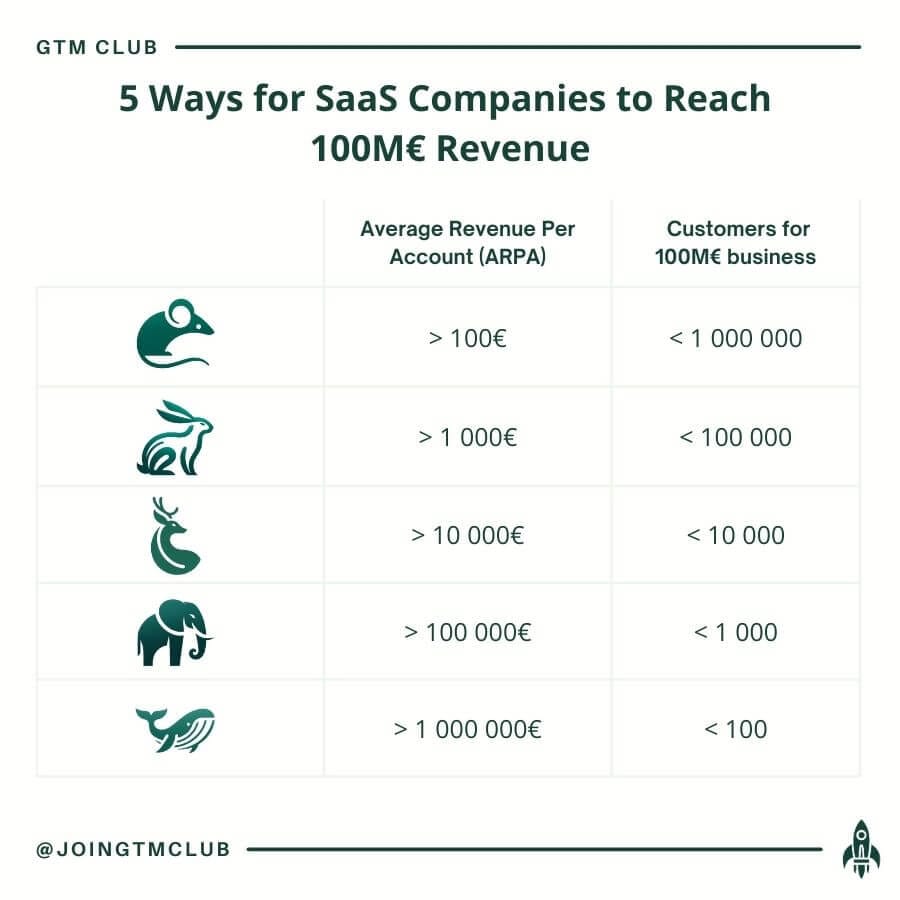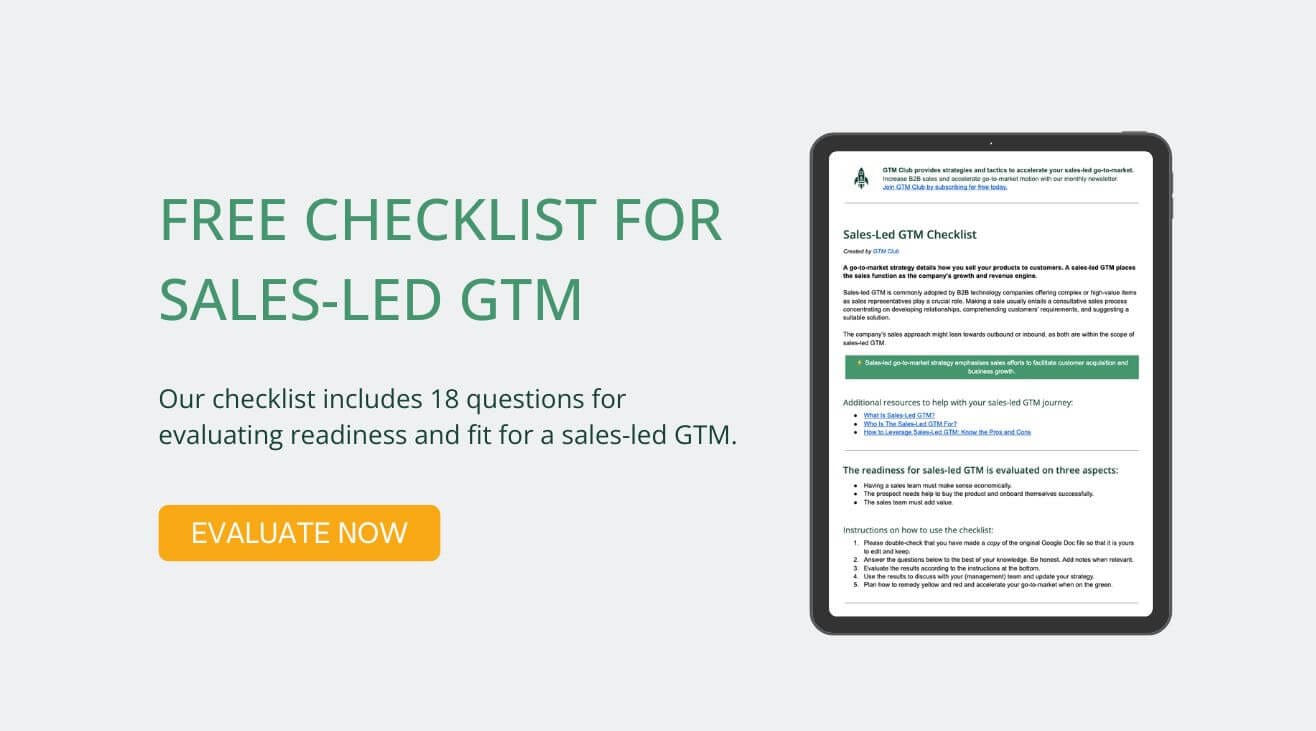Who Is The Sales-Led GTM For?
Sales-led GTM is a good growth strategy as long as certain criteria are met: The product can't be bought independently. Having a sales team must make economic sense. And sales team must add value during the sales process.

Sales resources, methodology, and go-to-market strategy must align with the company's products and services to scale a business. This is no easy feat for a company of any size. To help, Christoph Janz at Point Nine Capital created a well-known categorisation of deal sizes in tech, mainly for SaaS start-ups.
As you can see in the graph below, a mouse presents a deal with very little money each year, while a whale represents a whale-sized pile of annual income. Growing a company to 100M€ of annually recurring revenue (ARR) requires many more mouse-sized customers than whale-sized customers. To succeed, companies must match their GTM strategy to the size of accounts they want and can grow by.

Moving upwards to bigger targets increases the likelihood of success with sales-led go-to-market. There are exceptions to every rule, and while unlikely, it is possible to use sales-led GTM successfully while hunting mice and smaller rabbits.
For reasons explained below, it would be recommended to start utilising a sales force when revenue per account starts to close to a few thousand annually (sorry, Bambi) and even then, with a light touch. Ideally, marketing heavily supports deer hunting, but a fully grown deer justifies having a proactive extended SDR team and outbound sales motion. Bigger targets then move heavily on enterprise sales turf with dedicated teams.
Conditions For Successfully Implementing a Sales-Led GTM
For sales-led GTM to work, three main things must apply.
- Having a sales team must make sense economically.
- The prospect can't successfully buy the product and onboard themselves.
- Having a sales team must add value.
Let’s look at these one by one.
Economical Criteria
Having a sales team costs a lot of money. Good salespeople know their value. In addition to direct salary costs (inc. bonuses), they need a whole system to support them from a management, training and sales enablement point of view.
Good salespeople know their value.
It is always a bit business-dependent, but having a sales team hunting mice generally makes no financial sense, as marketing should attract them to the cheese (your product). Having the emphasis on the sales team starts to make sense from deer and above, as already mentioned. The average deal size and resulting margins must be high enough to justify multiple discussions with prospects before they buy (remember, for most companies, the win rate is less than 50%).
An important aspect to note here is that we are not discussing how sales are initiated: Sales-led GTM works for both inbound and outbound sales. The key difference here is to strongly emphasise the sales team leading the sales process with the prospects. Then, on a more tactical level, the company can discuss whether investing more in inbound makes sense over having a proactive SDR team leading outbound efforts.
For example, we at GTM Club use Canva for graphics. The money we pay for the licence is a tiny bunny. Having someone convince us to use the tool in the first place would not be (enough) profitable, with less than 150€ annually coming in after winning an opportunity with us. As Canva's results have shown, it is much better to let us explore the platform and start paying for more features.
Product Criteria
This is the opposite of Canva. The product is traditionally complex and requires customisation or a complex setup. We can use CRM as an example, as Salesforce is one of the companies famously utilising sales-led GTM.
Nowadays, Salesforce CRM can be tried for free. Still, a large organisation must go through a complex sales process to buy and implement it, which is often taken over by an implementation team from one of Salesforce's partners. It does not sound like a solution sales would independently buy online and start using successfully. No wonder Salesforce has active local sales teams working in the global markets to build a pipeline with elephants and whales.
If you want additional examples of complex sales, look at what is happening in cyber security. We see elephants!
It probably goes without saying that the product must also create enough benefits for customers to make sales at a high enough price point. How the benefits are then demonstrated to prospects varies per GTM strategy.
Products with features that create a wow effect during demo sessions directly accelerate sales.
User experience is essential for both sales and product-led growth, but it should be emphasised when prospects study the product independently. Then, they need to experience the value immediately and understand, without guidance, how to use various features. On the other hand, with a skilled sales professional, features that create a wow effect are worth buckets of gold in guided demo sessions. There is a middle ground: free trials, where a hands-on test follows a successful sales demo. Free trials turn into sales when set up correctly by the sales team.
Value-add From Sales
A sales team, big or small, needs to add value to justify its existence. And it must do so meaningfully for the prospects' experience and the company itself.
Too many companies have "fixed" non-working self-service models with sales teams. Paradoxically, the reason sometimes is the costs, as hiring a sales team of one or two reps might be cheaper than fixing the online funnel. In the long run, however, it rarely is, as adding a sales team to a sales process that does not require them tends to slow down the sales cycle. We are not using the sales team as a bandage but as a proper driver for revenue growth in sales-led GTM.
Enabling buying is an effective way for a sales team to add value, even when the product is otherwise accessible and easy to understand and implement. In B2B, decision-making requires multiple stakeholders and can be a complex process, so having a professional sales rep to help navigate opportunities to a decision and then carry the contract through the red-line phase. This seemed to be part of Zoom's growth strategy during the pandemic.
Buying does not happen without sales helping customers to make educated decisions.
In most cases, the value added from sales is clear: The sold product is complex, and as explained in the previous section, prospects need support in understanding how to best use it to solve their problem. Buying does not happen without sales helping (different than pushing) customers to make educated decisions. How this happens is, then again, product and company-specific decisions. For example, sales provide value in a pretty different way during a sales process for the same product when sold as inbound and outbound. Using the cyber security and backup solution as an example (see the complete example on how to align deliverables with an extended SDR team).
Inbound: The prospect already knows or suspects that revisions to cyber security are relevant. The additional value the sales executive focuses on is the specific concerns the prospect has mapped out already.
Towards Success With Sales-Led GTM!
To summarise, if your sales team is trying to accelerate sales but financials are falling behind, look under the hood.
If your sales are hunting too small animals, find a way to move upwards (or sell more efficiently). If your team is hunting an animal of the proper size, do they have the appropriate tools and methods to succeed?
No matter the answer, join GTM Club, and maybe we can help you find the answer 🚀





